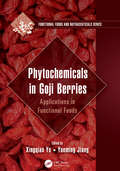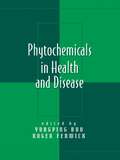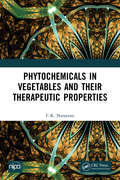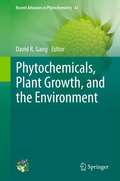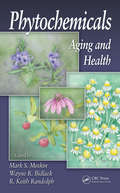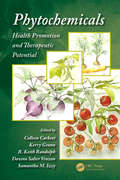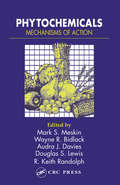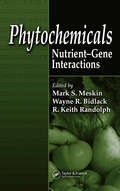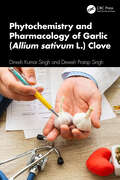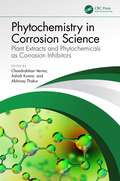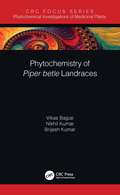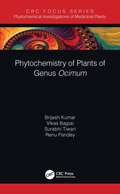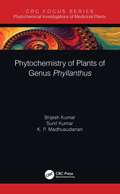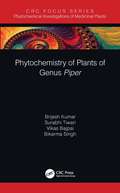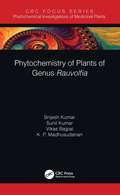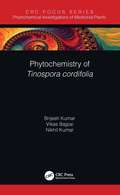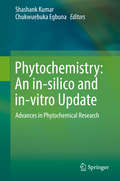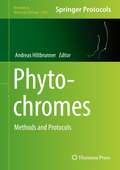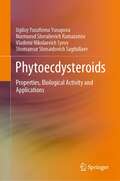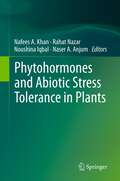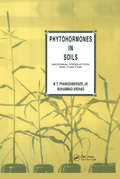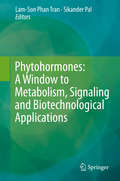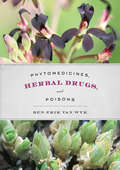- Table View
- List View
Phytochemicals in Goji Berries: Applications in Functional Foods (Functional Foods and Nutraceuticals)
by Xingqian Ye and Yueming JiangGoji berries (Lycium barbarum), which are widely distributed in Northwestern China, Southeastern Europe and the Mediterranean areas, have traditionally been employed in Chinese medicine from ancient times. Goji berries, also known as wolfberry, have become increasingly popular in the Western world because of their nutritional properties, often advertised as a superfood in Europe and North America. With the development of analysis methods, various chemical constituents have been identified, including carbohydrates, carotenoids, flavonoids, betaine, cerebroside, -sitosterol, amino acids, trace elements, vitamins and other constituents. Polysaccharides have been identified as one of the major active ingredients responsible for biological activities. Phytochemicals in Goji Berries: Applications in Functional Foods, a volume in the Functional Foods and Nutraceuticals Series, provides information about the chemical, biochemical, botanic properties, bioactive components and health benefits of Goji berries. It also discusses postharvest storage technology, processing technology, and the development and utilization of Goji berry by-products in medicinal foods and functional foods, as well as addressing food safety issues. Features: Provide information on Goji fruit origin and growing conditions, distribution, and biochemical properties Discusses such medicinal properties and health benefits of Goji berries as the capacity to lower blood pressure, treat anemia, maintain cholesterol levels in the normal range and decrease risk of cardiovascular disease. Additionally, Goji berries have anti-inflammatory and anti-tumor properties, among others Includes information on traditional products, new products and innovative processing technologies This book will serve college and university students majoring in food science, nutrition, pharmaceutical science, and botanical science. It also will serve as a unique reference for food science professionals pursuing functional foods, marketing expansion, as well as nutritional dietary management. Readers will obtain sound scientific knowledge of the nutritional value and health benefits of the different Goji berry products such as juice, cake, soup, snacks, and medicinal foods. Also available in the Functional Foods and Nutraceuticals series: Korean Functional Foods: Composition, Processing and Health Benefits, edited by Kun-Young Park, Dae Young Kwon, Ki Won Lee, Sunmin Park (ISBN 978-1-4987-9965-2) Phytochemicals in Citrus: Applications in Functional Foods, edited by Xingqian Ye (ISBN 978-1-4987-4272-6) Food as Medicine: Functional Food Plants of Africa, by Maurice M. Iwu (ISBN 978-1-4987-0609-4) For a complete list of books in the series, please visit our website at https://www.crcpress.com/Functional-Foods-and-Nutraceuticals/book-series/CRCFUNFOONUT
Phytochemicals in Health and Disease (Oxidative Stress And Disease Ser. #Vol. 12)
by Yongping Bao Roger Fenwick"� well-written and the content is clearly presented. � There are plentiful figures and tables, which are effectively labeled and adequately support the content. �highly recommended for academic and special libraries. �effectively presents current research on phytochemicals in a readable manner."- E-Streams "This landmark volume shows h
Phytochemicals in Vegetables and their Therapeutic Properties
by C.K. NarayanaThis book contains information on plant-based nutrients and phytochemicals in vegetable crops that are commonly consumed. The information generated by researchers using modern methods of biochemical analysis and results, mostly validated using cell line cultures or animal models, and to a limited extent on human volunteers have been presented. The vegetable crops have been grouped based on the family they belong to, because most often members of the same family have similar biomolecules as active ingredients and have similar effects on health. The book will help students/researchers/scientists and common man alike to look at the vegetables as protective foods, not just because it is said so, but with a scientific explanation.Note: T&F does not sell or distribute the hardback in India, Pakistan, Nepal, Bhutan, Bangladesh and Sri Lanka. This title is co-published with NIPA.
Phytochemicals, Plant Growth, and the Environment
by David R GangThis is the second volume since the reintroduction of the Recent Advances in Phytochemistry (RAP) series, an annual journal supported by the Phytochemical Society of North America. Topics appropriate for RAP include the biosynthesis of natural products and regulation of metabolism, the ecology of specialized metabolites and the evolution of their pathways, and the effects of natural products or plants on human health. Research appropriate for RAP involves genomics, proteomics, metabolomics, natural product structural determination and new technology development, medicinal chemistry and metabolic engineering, or any of the myriad of fields that are now closely associated with what may be called "traditional phytochemistry" and plant biochemistry. The advent of post-genomics-based ways of thinking, of systems biology, of synthetic biology, of comparative genomics/ proteomics/ transcriptomics/ metabolomics and especially of the introduction and establishment of a mentality that leads to support of large collaborative projects, has opened up many new doors to scientists interested and versed in the (bio)chemistry of plants. The goal of RAP is to highlight these developments. Two main types of articles are printed in RAP: Perspectives and Communications. Perspectives in RAP are expected to synthesize results from the primary literature and perhaps from new/novel results and place these in perspective relative to the broader field. These articles may be similar to review articles, but also are intended to present important ideas and hypotheses, and may present proposals for interesting directions in the field. It is the hope of the Editorial Board that these articles will be of great value to a large audience. Communications are intended to represent new advances in the field that will be of interest to a large audience. Articles of both types are typically solicited from the Society membership based on the content of the annual meeting talks, but in keeping with the title "Recent Advances in Phytochemistry" the editorial board reserves the right to solicit additional Perspectives and/or Communications from non-attendees as well (e.g., where an editorial board member has knowledge of an interesting recent advancement that would be of general interest to the society membership). All submissions to RAP go through a rigorous peer review process, overseen by the Editorial Board, which includes external review. RAP is indexed with Springer published journals. All RAP papers are available not only in the published volume form, but also electronically through Springer's online literature services. This marks a significant change from past volumes of RAP and it is the hope of the Editorial Board that this will lead to broader dissemination of the contents of and greater interest in RAP. This 42nd volume of RAP includes a total of seven articles, many, but not all, based on talks presented at the 50th annual meeting of the PSNA. As was seen in RAP volume 41, These seven Perspectives give a very good picture of the breadth of plant (bio)chemistry research in North America, which is also indicative of the state of the field worldwide. Each of these articles describes the integration of several different approaches to ask and then answer interesting questions regarding the function of interesting plant metabolites, either in the plant itself or in interactions with the environment (natural setting or human health application). Many of these Perspectives have a strong ecological focus. McCormick et al. review the discovery of the biosynthetic pathway leading to production of trichothecene mycotoxins such as the T-2 toxin in plant pathogenic and other fungi. These compounds play very important roles in plant-pathogen interaction, and are very significant from a human health perspective. In a complementary paper, Duringer et al. describe recent technological advances in monitoring mycotoxins such as ergovaline and lysergic acid in forage crops, using state of the art and highly sensitive mass spectrometric means. Gross reviews the current...
Phytochemicals: Aging and Health
by R. Keith Randolph Mark S. Meskin Wayne R. BidlackThe fastest growing demographic in both developed and developing societies around the world, the elderly bring unique medical and financial health-care burdens. In response to this phenomenon, a large and growing body of research is directed toward the science of healthy aging. A substantial amount of observational data points to the consumption o
Phytochemicals: Health Promotion and Therapeutic Potential
by Colleen Carkeet Kerry Grann R. Keith Randolph Dawna Salter Venzon Samantha M. IzzyIncreasing knowledge of the various protective effects of phytochemicals has sparked interest in further understanding their role in human health. Phytochemicals: Health Promotion and Therapeutic Potential is the seventh in a series representing the emerging science with respect to plant-based chemicals. Drawn from the proceedings at the Seventh In
Phytochemicals: Mechanisms of Action
by R. Keith Randolph Mark S. Meskin Wayne R. Bidlack Audra J. Davies Douglas S. LewisPhytochemicals: Mechanisms of Action is the latest volume in a highly regarded series that addresses the roles of phytochemicals in disease prevention and health promotion. The text, an ideal tool for scientists and researchers in the fields of functional foods and nutraceuticals, links diets rich in plant-derived compounds, such as fruit, vegetabl
Phytochemicals: Nutrient-Gene Interactions
by R. Keith Randolph Mark S. Meskin Wayne R. BidlackUnderstanding phytochemical-gene interactions provides the basis for individualized therapies to promote health as well as prevent and treat disease. The authors of Phytochemicals: Nutrient-Gene Interactions examine the interactions between phytochemicals and the human genome and discuss the impact these interactions have on health, aging, a
Phytochemistry and Pharmacology of Garlic (Allium sativum L.) Clove
by Dinesh Kumar Singh Devesh Pratap SinghThe present book is an attempt to provide a thorough overview on the origin of garlic, history of garlic chemistry, garlic preparations and their use in folklore, health benefits of garlic, garlic as pesticide and its adverse effects. Garlic (Allium sativum) is also used as a popular herbal alternative therapy. There is a lack of consolidated literature on the health benefits of garlic, this book will provide a comprehensive compendium on these benefits. Though it is a scientific research-based knowledge compilation, it will be also equally beneficial to science students as well as the lay reader.Salient features: Focuses on the origin and history of garlic, its botanical characterization and preparation Discusses health benefits of garlic based on scientific studies, research and their applications Deals with pesticidal, insecticidal, molluscicidal and nematicidal activities of garlic Elucidates the benefits of garlic in cardiovascular diseases, antidiabetic effect, anticancer potential and antioxidant activity
Phytochemistry in Corrosion Science: Plant Extracts and Phytochemicals as Corrosion Inhibitors
by Chandrabhan VermaPhytochemistry in Corrosion Science covers the use of plant extracts/phytochemicals in corrosion mitigation with industrial applications. It explores innovative and characterization approaches toward the utilization of plant extracts and their phytochemicals as potential corrosion inhibitors for several metals and their alloys.Providing a comprehensive overview of the green aspects of plant extracts as corrosion inhibitors, this book discusses the preparation of aqueous and organic phase extracts, and their advantages, disadvantages, and use for different aggressive media. It also examines aqueous and organic extracts that have been successfully used as corrosion inhibitors for various metals and electrolyte combinations.This book will be a useful reference for undergraduate and graduate students and academic researchers in the fields of phytochemistry, corrosion science and engineering, environmental science, chemical engineering, green chemistry, and mechanical/industrial engineering.
Phytochemistry of Bryophytes (Progress in the Chemistry of Organic Natural Products #126)
by A. Douglas Kinghorn Heinz Falk Simon Gibbons Yoshinori Asakawa Ji-Kai Liu Verena M. DirschThis book discusses the phytochemistry of bryophytes, with a particular focus on their biologically active natural products and their potential applications in medicine, cosmetics, and as foods. Bryophytes, which include the mosses, liverworts, and hornworts, produce a plethora of terpenoids, phenolic compounds, and polyketides that exhibit diverse pharmacological activities, including anti-inflammatory, antiobesity, antioxidant, cytotoxic, and muscle-relaxant effects. The volume also explores the characteristic odors and flavors of bryophytes, as well as their possible use in the cosmetics industry, as food additives, and ultimately as medicinal drugs. Additionally, the biosynthesis pathways and synthesis of selected bioactive bryophyte compounds are discussed, highlighting the potential of these fascinating and ancient plants as a source of novel and valuable natural products.
Phytochemistry of Piper betle Landraces (Phytochemical Investigations of Medicinal Plants)
by Brijesh Kumar Vikas Bajpai Nikhil KumarPiper betle (betel vine) a pan-Asiatic, tropical plant, which can also grow under mild subtropical areas, is essentially grown for leaves which are chewed with array of additives besides slaked lime. The plant is cultivated widely in India and its surrounding areas. Phytochemistry of Piper betel landraces presents a brief on the distribution, historical and cultural aspects, and properties ascribed to this plant in the ancient texts. Phytochemical and pharmacological information has also been included to underscore the importance of this plant in the present time. A detailed account on metabolic profiling employing modern methods is included, such as real-time, direct analysis of the flight mass spectrometric method and chemometric analysis for characterization of the available biodiversity and signatures specific to gender and geographical location. It was also possible to identify the gender of unknown landraces, with the help of principal component analysis. Features: Elaborates on the chemical diversity within Piper betle. Piper betle leaves have mouth freshening antimicrobial compounds. Use of chemical signatures for the identification of different Piper betle landraces, their gender and geographical locations.
Phytochemistry of Plants of Genus Ocimum (Phytochemical Investigations of Medicinal Plants)
by Brijesh Kumar Surabhi Tiwari Vikas Bajpai Renu PandeyOcimum species has been used as a traditional remedy for various ailments such as arthritis, bronchitis, cold, conjunctivitis, diarrhea, dysentery, and flatulence, as well as for healing wounds and lowering blood glucose level. These are characterized by variations in their morphology such as the shape, size and pigmentation of leaves, which cause differences in chemical composition and affect the commercial value of this genus. This book describes phytochemical investigations of Ocimum species using LC-MS/MS instruments to study qualitative and quantitative variations of phytochemicals in different Ocimum species. Features: Collection of Ayurvedic features and scientific analytical and pharmacological evidence of most important medicinal plants of genus Ocimum. Chemical signatures for the identification of Ocimum species. Easy-to-use analytical procedure for quality control of plants of Ocimum species and its herbal products.
Phytochemistry of Plants of Genus Phyllanthus (Phytochemical Investigations of Medicinal Plants)
by Sunil Kumar Brijesh Kumar K. P. MadhusudananSeveral Phyllanthus species are widely used in traditional medicine and herbal formulation for the treatment of a variety of ailments such as flu, dropsy, diabetes, jaundice and bladder calculus. The medicinal properties of these species are due to the presence of lignans, flavonoids, tannins, alkaloids and terpenoids. Phyllanthin and hypophyllanthin are the major lignans from Phyllanthus species having estrogenic properties that reduce toxicity and vascular tension, and protect hepatocytes. This book deals with the importance of separation techniques in screening of major lignans, flavonoids and terpenoids in Phyllanthus species using HPLC/UPLC coupled with mass spectrometric techniques. Features: Collection of Ayurvedic features and scientific evidence of important medicinal plants. Screening of major lignans, flavonoids and terpenoids in plant parts/whole plant extracts and their geographical variations in Phyllanthus amarus. Easy-to-use analytical procedure for the quality control of Phyllanthus and its products.
Phytochemistry of Plants of Genus Piper (Phytochemical Investigations of Medicinal Plants)
by Brijesh Kumar Surabhi Tiwari Vikas Bajpai Bikarma SinghPiper is the representative genus of family Piperaceae. Piper species are pan-tropical in distribution and found in both the hemispheres. As the king of all spices, black pepper, Piper nigrum, led to the global expeditions culminating in the discovery of India and the new world. Piper species have been reported to possess various pharmacological activities such as insecticidal, antibacterial, anti-inflammatory, antiplatelet, anti-hypertensive, antithyroid, antitumor activities and hepatoprotective properties. Botanical authentication of the plants of Piper species is difficult because of the morphological similarity among the species. This book describes ultra-performance liquid chromatography coupled with triple quadrupole electrospray tandem mass spectrometry in multiple reactions monitoring (MRM) mode to study the quantitative variation of thirteen bioactive markers in different plant parts of ten Piper species. Features: Collection of Ayurvedic features and scientific evidence of the most important medicinal plants of Piper species. Describes chemical signatures for identification of Piper species. Provides easy-to-use analytical procedure for quality control of Piper species and its products.
Phytochemistry of Plants of Genus Rauvolfia (Phytochemical Investigations of Medicinal Plants)
by Sunil Kumar Brijesh Kumar Vikas Bajpai K. P. MadhusudananRauvolfia species, commonly known as Sarpagandha, has been traditionally used in Ayurveda for curing high blood pressure, hypertension, snake bites, fever, and mental illnesses. Due to its wide variety and differences in chemical composition, it is necessary to develop an efficient and reliable method for rapid screening and determination of phytochemicals in the extracts of the Rauvolfia species. This book will provide qualitative and quantitative comparative phytochemical investigations of selected medicinal plants from the Rauvolfia genus using liquid chromatography-mass spectrometry (LC-MS) techniques. The results will help in assuring the efficacy and safety of Rauvolfia herbal products. Features: Collection of Ayurvedic features and scientific evidence of important medicinal plants. Discusses chemical signatures for the identification of Rauvolfia (Sarpagandha) and its products. Easy-to-use analytical procedure for quality control of Rauvolfia and its products.
Phytochemistry of Tinospora cordifolia (Phytochemical Investigations of Medicinal Plants)
by Brijesh Kumar Vikas Bajpai Nikhil KumarTinospora cordifolia stem is used as a tonic, vitalizer, and as a remedy for metabolic disorders to treat allergies, diabetes, dysentery, jaundice, heart diseases, leprosy, rheumatoid arthritis, skin diseases, and urinary disorders. It shows anti-inflammatory, analgesic, antipyretic actions and immunosuppressive effects. This book focuses on providing gender and geographical location-based differences in the phytoconstituents of T. cordifolia by the liquid chromatography mass spectrometric method. These methods have potential use in the quality control of T. cordifolia and the screening of herbal preparations. Features: Compilation of ayurvedic features of one of the most important plants of the Indian system of medicines. Useful for all ayurvedic practitioners, researchers, faculty, students, and herbal product manufacturers. Application of advance hyphenated LC-MS techniques for variation study in phytoconstituents.
Phytochemistry: Advances in Phytochemical Research
by Shashank Kumar Chukwuebuka EgbunaPhytochemistry is the branch of science that deals with the study of plant-derived chemicals or compounds, which are also known as phytochemicals or plant-derived secondary metabolites. Plants are known to produce phytochemicals that are essential for their growth and reproduction, as they protect them from insects, pathogens, and herbivores. Some of the major groups of plant-derived secondary metabolites are phenolics, flavonoids, terpenoids, alkaloids, tannin etc. Plant-derived phytochemicals are pharmacologically active and have the potential to cure various human diseases and disorders. Natural plant products have been known for their medicinal properties for untold years, and form the basis of several medicinal systems such as Chinese, Unani, and Ayurvedic Medicine. This book offers an essential introduction to phytochemicals and their synthetic analogues. It discusses various in silico approaches used to identify pharmacologically active phytochemicals and their biological activities, as well as in vitro and in vivo models/assays that have been utilized for the pharmacological profiling of plant-derived products to combat cancer, diabetes, cardiovascular diseases and neurological disorders. The intended audience includes upper-level undergraduate and graduate students; researchers and scientists from the pharmaceutical/food chemistry/nutrition sciences/biochemistry, and clinical biochemistry fields; and medical students. Sharing the latest findings, the book will familiarize these readers with the concepts, chemistry, and tremendous potential of phytochemistry.
Phytochromes: Methods and Protocols (Methods in Molecular Biology #2026)
by Andreas HiltbrunnerThis volume aims at providing readers with protocols to enhance their research for the next decade of phytochrome research. The chapters in this book cover topics such as tests for light-dependent interaction of phytochrome binding proteins using yeast two hybrid assays, in vitro pull down, and co-immunoprecipitation from stable transgenic lines; investigations into phosphorylation, SUMOylation, and ubiquitination of phytochromes and other proteins; a look at how in vivo spectroscopy can be used to measure Pfr levels of phytochrome in planta; identifying hormonal action and co-action in light-regulated processes; and ways to use the CRISPR/Cas9 system to generate Physcomitrella mutant lines. Written in the highly successful Methods in Molecular Biology series format, chapters include introductions to their respective topics, lists of the necessary materials and reagents, step-by-step, readily reproducible laboratory protocols, and tips on troubleshooting and avoiding known pitfalls.Cutting-edge and comprehensive, Phytochromes: Methods and Protocols serves as a guideline to researchers who are new to the field, and a stepping stone for experienced researchers looking to expand their knowledge of this evolving field.
Phytoecdysteroids: Properties, Biological Activity and Applications
by Ugiloy Yusufovna Yusupova Nurmurod Sheralievich Ramazonov Vladimir Nikolaevich Syrov Shomansur Shosaidovich SagdullaevThis book presents the results of comprehensive research of an inadequately studied class of secondary plant metabolites: phytoecdysteroids, which are structural analogs of the hormones of molting and metamorphosis of arthropods. The chemical structures of ecdysteroids isolated from plants of the genera Ajuga, Rhaponticum, and Silene have been established. Data on the physicochemical characteristics, reactivity, metabolism, and biological activity of these compounds are presented in this book. Considerations of the role of ecdysteroids in plants are expressed and data on their pharmacological properties are also given. Issues regarding the use of phytoecdysteroids in practical medicine and, accordingly, the technological aspects of deriving drugs on their basis and biologically active food additives of a fortifying type of action are considered as well.The book is intended for specialists in the fields of bioorganic and organic chemistry, biochemistry, biotechnology, and pharmacology. It is also relevant to scientists of various profiles and teachers and students interested in the problems of the chemistry of natural and physiologically active substances.
Phytohormones and Abiotic Stress Tolerance in Plants
by Naser A. Anjum Nafees A. Khan Noushina Iqbal Rahat NazarPlants are sessile and prone to multiple stresses in the changing environmental conditions. Of the several strategies adopted by plants to counteract the adverse effects of abiotic stress, phytohormones provide signals to allow plants to survive under stress conditions. They are one of the key systems integrating metabolic and developmental events in the whole plant and the response of plants to external factors and are essential for many processes throughout the life of a plant and influence the yield and quality of crops. The book 'Phytohormones and Abiotic Stress Tolerance in Plants' summarizes the current body of knowledge on crosstalk between plant stresses under the influence of phytohormones, and provides state-of-the-art knowledge of recent developments in understanding the role of phytohormones and abiotic stress tolerance in plants. This book presents information on how modulation in phytohormone levels affect regulation of biochemical and molecular mechanisms.
Phytohormones in Abiotic Stress
by Dhandapani Raju R Ambika Rajendran Ayyagari Ramlal Virendra Pal SinghPlants are continuously exposed to different environmental stresses that negatively impact their physiology and morphology, resulting in production reduction. As a result of constant pressure, plants evolve different mechanisms for sustenance and survival. Hormones play a major role in defences against the stresses and stimulate regulatory mechanisms. One of the ways through which they mitigate stress is via the production of hormones like auxins, ethylene, jasmonic acid, etc. The phytohormones help in signaling and enhance the chances of their survival. Plant hormones play many vital roles from integrating developmental events, physiological and biochemical processes to mediating both abiotic and biotic stresses. This book aims to highlight these issues and provide scope for the development of tolerance in crops against abiotic stresses to maximize yield for the growing population. There is an urgent need for the development of strategies, methods and tools for the broad-spectrum tolerance in plants supporting sustainable crop production under hostile environmental conditions.The salient features are as follows:• It includes both traditional and non-traditional phytohormones and focuses on the latest progress emphasizing the roles of different hormones under abiotic stresses.• It provides a scope of the best plausible and suitable options for overcoming these stresses and puts forward the methods for crop improvement.• It is an amalgamation of the biosynthesis of phytohormones and also provides molecular intricacies and signalling mechanisms in different abiotic stresses.• This book serves as a reference book for scientific investigators from recent graduates, academicians and researchers working on phytohormones and abiotic stresses.
Phytohormones in Soils Microbial Production & Function (Books In Soils, Plants, And The Environment Ser.)
by Muhammad Arshad W. T. Frankenberger Jr.Details the various physiological responses in plants caused by microbially derived phytohormones--examining the microbial synthesis of the five primary classes of plant hormones. Exploring novel methods for improving symbiotic associations vital for plant growth and development.
Phytohormones: A Window to Metabolism, Signaling and Biotechnological Applications
by Lam-Son Phan Tran Sikander PalAbiotic and biotic stresses adversely affect plant growth and productivity. The phytohormones regulate key physiological events under normal and stressful conditions for plant development. Accumulative research efforts have discovered important roles of phytohormones and their interactions in regulation of plant adaptation to numerous stressors. Intensive molecular studies have elucidated various plant hormonal pathways; each of which consist of many signaling components that link a specific hormone perception to the regulation of downstream genes. Signal transduction pathways of auxin, abscisic acid, cytokinins, gibberellins and ethylene have been thoroughly investigated. More recently, emerging signaling pathways of brassinosteroids, jasmonates, salicylic acid and strigolactones offer an exciting gateway for understanding their multiple roles in plant physiological processes. At the molecular level, phytohormonal crosstalks can be antagonistic or synergistic or additive in actions. Additionally, the signal transduction component(s) of one hormonal pathway may interplay with the signaling component(s) of other hormonal pathway(s). Together these and other research findings have revolutionized the concept of phytohormonal studies in plants. Importantly, genetic engineering now enables plant biologists to manipulate the signaling pathways of plant hormones for development of crop varieties with improved yield and stress tolerance. This book, written by internationally recognized scholars from various countries, represents the state-of-the-art understanding of plant hormones' biology, signal transduction and implications. Aimed at a wide range of readers, including researchers, students, teachers and many others who have interests in this flourishing research field, every section is concluded with biotechnological strategies to modulate hormone contents or signal transduction pathways and crosstalk that enable us to develop crops in a sustainable manner. Given the important physiological implications of plant hormones in stressful environments, our book is finalized with chapters on phytohormonal crosstalks under abiotic and biotic stresses.
Phytomedicines, Herbal Drugs, and Poisons
by Ben-Erik van WykPlants have been used to treat disease throughout human history. On a clay slab that dates back approximately five thousand years, the Sumerians recorded medicinal recipes that made use of hundreds of plants, including poppy, henbane, and mandrake. During the Middle Ages, monks commonly grew and prescribed plants such as sage, anise, and mint in their monasteries. And as the market for herbal remedies and natural medicine grows, we continue to search the globe for plants and plant compounds to combat our various ailments. In Phytomedicines, Herbal Drugs, and Poisons, Ben-Erik van Wyk offers a richly illustrated, scientific guide to medicinal and poisonous plants, including those used for their mind-altering effects. Van Wyk covers approximately 350 species—from Aloe vera and Ephedra sinica to Cannabis sativa and Coffea arabica—detailing their botanical, geographical, pharmacological, and toxicological data as well as the chemical structures of the active compounds in each. Readers learn, for example, that Acacia senegal, or gum acacia, is used primarily in Sudan and Ethiopia as a topical ointment to protect the skin and mucosa from bacterial and fungal infections, and that Aconitum napellus, more commonly known as aconite, is used in cough syrups but can be psychedelic when smoked or absorbed through the skin. With 350 full-color photographs featuring the plants and some of their derivative products, Phytomedicines, Herbal Drugs, and Poisons will be an invaluable reference not only for those in the health care field but also for those growing their own medicinal herb gardens, as well as anyone who needs a quick answer to whether a plant is a panacea or a poison.
